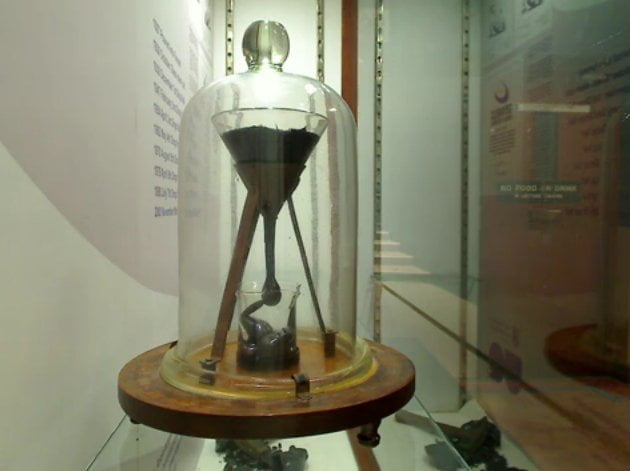To round out our series on fluid dynamics in the Ig Nobel Prizes (which are not the same thing as the actual Nobel Prizes), here are some of the other winners. Last year Mayer and Krechetnikov won for a study on coffee sloshing when people walk. We’ve mentioned the pitch-drop experiment measuring the viscosity of an extremely viscous fluid a couple times; Mainstone and Parnell won a 2005 Ig Nobel for that (on-going) work. Another 2005 prize went to Meyer-Rochow and Gal for calculating the pressures involved in penguin defecation. (Yes, seriously.) A avian-related award was also handed out to B. Vonnegut for estimating tornado wind speeds by their ability to strip a chicken of its feathers. And, finally, for those looking to interest undergraduate lab students in mathematics and fluid dynamics, I suggest following the lead of 2002 winner A. Leike who demonstrates laws of exponential decay with beer head. (Photo credit: S. Depolo)
Tag: pitch

Dublin’s Pitch-Drop Experiment
Readers may recall the University of Queensland’s pitch-drop experiment, recognized as the longest continuously running experiment in the world. Back in 1927, a professor started the experiment with the goal of measuring the extremely high viscosity of pitch. Since then, only eight drops have fallen. Queensland’s is not the only version of this experiment, though; Trinity College Dublin has a similar set-up and have just caught a falling pitch drop on camera for the first time ever. Take a look in the video above. Queensland is expecting a drop to fall sometime this year as well. (Video credit: Trinity College Dublin Physics; via SciAm)

The Pitch Drop Experiment
Sometimes everyday materials are more fluid than they seem. In 1927, Professor Thomas Parnell of the University of Queensland started what is now the longest continuously running laboratory experiment when he filled a sealed glass funnel with a sample of heated tar pitch. After allowing 3 years for the pitch to settle, the funnel’s stem was unsealed and the pitch has been slowly dripping ever since. Now, over 80 years later, the ninth drop is still just forming. No one has witnessed the fall of a pitch drop but the odds are good that someone will catch the ninth drop now that it has its own webfeed. The experiment, which won an Ig Nobel Prize in 2005, demonstrates the incredibly high viscosity of pitch, which the researchers estimated at 11 orders of magnitude larger than water at room temperature. (submitted by jshoer)

The Sound of Helium
Gases of different density are good for more than just physics demonstrations. They also affect the transmission of sound waves, thereby altering our perception of pitch. As fun as sulfur hexafluoride is, though, don’t go playing with it at home; it’s an extremely potent greenhouse gas.


